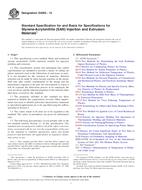We need your consent to use the individual data so that you can see information about your interests, among other things. Click "OK" to give your consent.
ASTM D6777-02(2010)e1
Standard Test Method for Relative Rigidity of Poly(Vinyl Chloride)(PVC) Siding (Includes all amendments And changes 5/17/2016).
Automatically translated name:
Standard Test Method for Relative Rigidity of Poly(Vinyl Chloride)(PVC) Siding
STANDARD published on 15.11.2010
The information about the standard:
Designation standards: ASTM D6777-02(2010)e1
Note: WITHDRAWN
Publication date standards: 15.11.2010
SKU: NS-36484
The number of pages: 4
Approximate weight : 12 g (0.03 lbs)
Country: American technical standard
Category: Technical standards ASTM
The category - similar standards:
Annotation of standard text ASTM D6777-02(2010)e1 :
Keywords:
PVC siding, rigidity, rigidity index, Poly(vinyl chloride)(PVC) siding/soffit, Poly(vinyl chloride)(PVC)--specifications, Quality control (QC)--plastics, Rigidity test, Rigid plastics, Stiffness--plastics, ICS Number Code 83.080.20 (Thermoplastic materials)
Additional information
| Significance and Use | ||||||||||
|
Vinyl siding with higher rigidity is often easier to install and expected to provide a straighter appearance when installed on walls having an uneven surface. The rigidity of vinyl siding is believed to be controlled primarily its characteristic configuration and is not believed to be significantly influenced by manufacturing variables. Siding weight has little influence on this test. |
||||||||||
| 1. Scope | ||||||||||
|
1.1 This procedure describes a method to determine a numerical value indicating the relative rigidity or stiffness of vinyl siding panels. This procedure is not intended for routine quality control inspection during the manufacture of vinyl siding. The rigidity of vinyl siding is believed to be controlled primarily by its configuration and is not believed to be significantly influenced by manufacturing variables. 1.2 Vinyl siding with higher rigidity is often easier to handle and install. It is expected to provide a straighter appearance when installed on walls having an uneven surface. 1.3 All other vinyl siding requirements and test methods can be identified through Specification D3679. 1.4 There is no known ISO equivalent to this standard. 1.5 This standard does not purport to address all of the safety concerns, if any, associated with its use. It is the responsibility of the user of this standard to establish appropriate safety and health practices and determine the applicability of regulatory limitations prior to use. |
||||||||||
| 2. Referenced Documents | ||||||||||
|
Similar standards:
Historical
1.4.2007
Historical
15.4.2009
Historical
1.7.2013
Historical
1.11.2007
Historical
1.3.2014
Historical
15.11.2012
We recommend:
Technical standards updating
Do you want to make sure you use only the valid technical standards?
We can offer you a solution which will provide you a monthly overview concerning the updating of standards which you use.
Would you like to know more? Look at this page.



 ASTM D3895-07
ASTM D3895-07 ASTM D3935-09
ASTM D3935-09 ASTM D4066-13
ASTM D4066-13 ASTM D4094-07
ASTM D4094-07 ASTM D4101-14
ASTM D4101-14 ASTM D4203-12
ASTM D4203-12
 Cookies
Cookies
